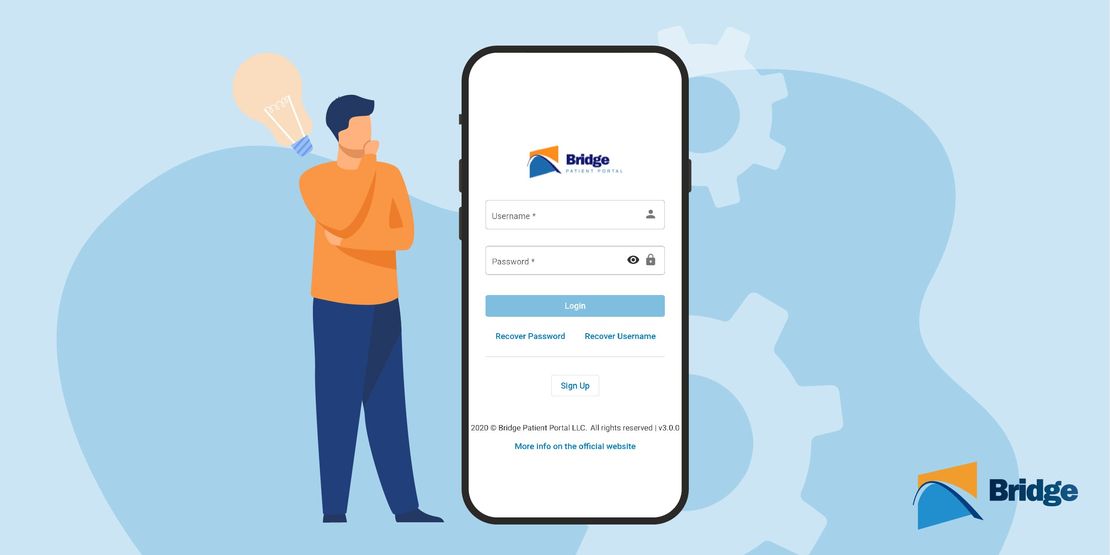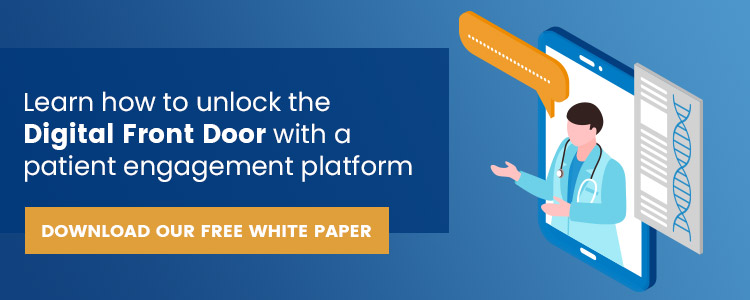Rethinking The Patient Portal For Healthcare
- Imogen Goodman
- February 22, 2021

The current digital healthcare landscape
Both in the United States and beyond, the healthcare sector is currently undergoing a period of immense change. Government regulation[¹] and consumer demands[²] are expanding as part of a natural progression towards the consumerization and digitalization of healthcare, while the adoption of new technologies such as the patient portal for healthcare to deal with these challenges continues to accelerate in the wake of COVID-19.
In the post-pandemic world, healthcare organizations are coming to realize the necessity of offering more patient-facing digital tools for their patients. However, many of these same organizations are lumbered with antiquated Electronic Health Record (EHR) systems that were designed to cater exclusively to clinicians – a scenario that has, in turn, created a market for add-on patient-facing solutions.
According to John Deutsch, CEO, and founder of Bridge Patient Portal, those healthcare organizations that have decided to respond quickly and become early adopters of these one-off patient engagement solutions have often had trouble translating these into a comprehensive offer for patients.
“Consumers are now saying; I want online scheduling, I want mobile check-in, I want telehealth, which has pushed the most forward-looking healthcare providers to purchase more and more add-ons to their digital suite,” he explained. “The problem is that, after buying all these additional solutions, these provider groups often don’t have the time to integrate them properly into their existing EHR/Revenue Cycle Management (RCM) or Practice Management (PM) and with each other.”
This, he says, has created a piecemealed patient engagement landscape that falls far short of the patient portal for healthcare that today’s consumers expect. Instead, this fragmented suite of software for patient engagement remains inefficient for healthcare organizations and provider-groups, unattractive for patients, and dangerously weak when it comes to data security and privacy.
The effects of fragmented patient engagement tools on communications and data security
With a wealth of sensitive patient and company data at stake, security continues to be a major issue for the healthcare sector. Major health organizations have been the victims of ransomware attacks[³] in the recent past, and the proliferation of these add-on digital solutions has made the situation even riskier.
Recommended: Consolidate Your Software For Patient Engagement To Avoid Security & Compliance Risks
“Having multiple poorly integrated Software as a Service (SaaS) tools leaves a lot of these organizations really vulnerable to cyberattacks,” said Deutsch. “In short, the more pipes going in and out of a source system such as an EHR, PM, or RCM, the more data security risks you face.”
As well as exposing organizations to data breaches, a scattergun approach to patient engagement can also impact on providers’ relationships with their patients.
Having multiple digital SaaS tools rather than a single patient portal solution may mean that patient preferences on communications go unheeded since these add-ons tools rarely communicate with each other. Suppose a patient chooses to opt-out of email communications because they share an email account with their spouse, or would prefer not to receive SMS on a business phone. In that case, there’s a high likelihood that this will get overlooked on at least one of the many add-on tools being used.
“When staff are forced to log in to multiple systems and then change preferences on all of these systems, there’s far more potential for human error,” explained Deutsch.
Compared with a fully integrated patient portal for healthcare – which would involve ticking a single box to update patient preferences – disjointed add-on tools can lead to duplicated, irrelevant and unwanted communications with patients, potentially opening healthcare organizations up to accusations of non-compliance.
How a patient portal for healthcare can be the foundation of a modern patient engagement strategy
In an ever-developing healthcare sector, digitally mature healthcare organizations who were early adopters of new patient-facing tools are now starting to see the value of a more coordinated and cohesive approach.
Along with newer health IT vendors – who had previously focussed on a few popular digital solutions such as telehealth, messaging, and scheduling – these organizations are slowly but surely switching over to a comprehensive patient portal for healthcare like the one provided by Bridge.
This, according to Deutsch, is a natural next step for patient engagement, combining the familiar interface of a patient portal that patients are accustomed to with the smooth usability of the new generation of SaaS tools provided by newer healthcare start-ups.
“Bridge attracts a provider group that has typically already been down this road of acquiring multiple one-off patient engagement solutions,” he said. “This group is now looking to consolidate these solutions for an improved patient experience, lower software licensing costs, and greater staff efficiency.”
The key to this approach is that, with a fully comprehensive patient engagement platform, patients only have to remember one login regardless of whether they are booking an appointment, ordering a repeat prescription, or receiving their lab results. This can lead to improved data security, increased efficiency, and a more engaged, satisfied, and active patient community.
“The shift in mentality that is occurring both among software vendors and healthcare provers is a testament to the fact that this kind of patient portal can be the foundation of any effective patient engagement strategy,” added Deutsch. “With a comprehensive patient portal for healthcare that offers both easy accessibility and a multitude of modern digital services in one place, healthcare organizations can move past the era of antiquated clinician-facing EHRs and embrace the new era of user-friendly healthcare.”
- Federal Register. (2020). 21st Century Cures Act: Interoperability, Information Blocking, and the ONC Health IT Certification Program. [online] Available at: https://www.federalregister.gov/documents/2020/05/01/2020-07419/21st-century-cures-act-interoperability-information-blocking-and-the-onc-health-it-certification.
- Accenture 2019 Digital Health Consumer Survey. [online] accenture.com. Available at:https://www.accenture.com/_acnmedia/pdf-94/accenture-2019-digital-health-consumer-survey.pdf
- Bowen, C. (2020). Ransomware in healthcare: The inevitable truth. [online] MedCity News. Available at: https://medcitynews.com/2020/10/ransomware-in-healthcare-the-inevitable-truth/
